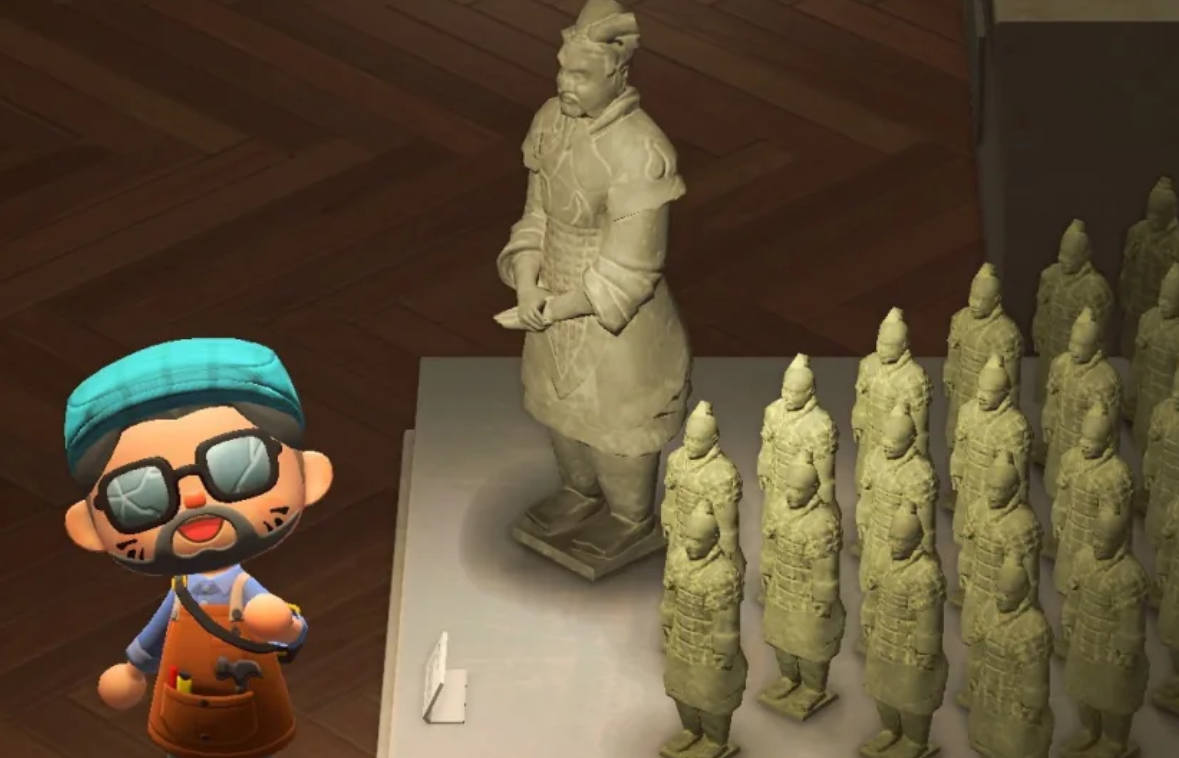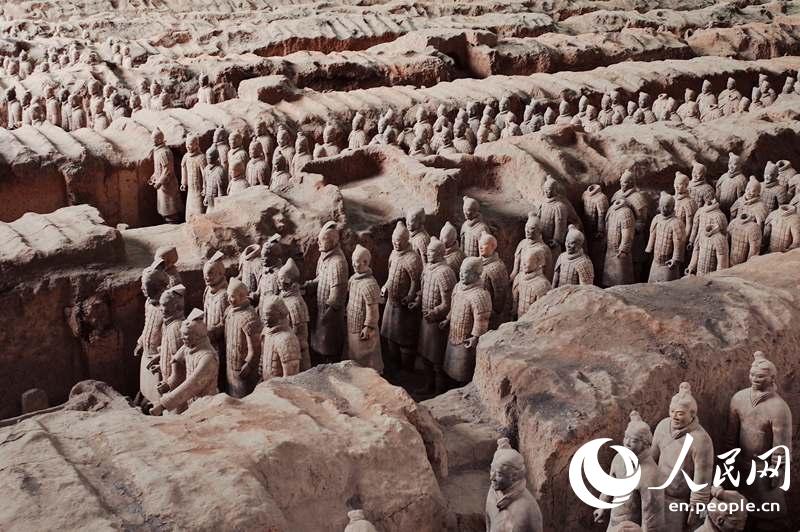


Terracotta Army in Animal Crossing. [Photo: Internet]
Animal Crossing: New Horizons, a social simulation video game, drew global attention by reaching five million in digital sales within a month recently. In the game, players can visit an art museum, collecting antiques and artworks from around the world, and its Chinese section featured a group of Terracotta Army soldiers, which represent the pinnacle of Chinese artistry.
You may have heard of the famous Terracotta Army, but do you know the history and stories behind those grand clay figurines? Follow us and check it out!
Story behind the discovery

For thousands of years, the Terracotta Army remained buried in their secret underground palace without being disturbed, though farmers and thieves from different dynasties would occasionally stumble across terracotta figures and fragments of the Qin necropolis, such as roof tiles, bricks and chunks of masonry.
It was not until March 29, 1974 that the first Terracotta Army was discovered by farmers digging a water well near the Qin Emperor’s tomb. At first, the farmers thought the clay figurines were ancient josses who were there to guard over the land, and decided to worship them as their protectors.
Chinese archaeologists soon got news of this and started to investigate this largest group of pottery figurines ever discovered. Researchers found that the clay army represented a form of funerary art buried with Qin Shihuang, China’s first emperor, and their purpose was to protect the emperor in his afterlife. A museum complex has since been constructed, with a great dome covering the whole underground army.
Unparalleled artistic value
Dubbed the world’s eighth ancient wonder, the Terracotta Army is a collection of life-sized sculptures depicting the armies of Qin Shihuang. Dating from approximately the late third century BCE, each figure has its own unique features, down to the face and toes. The Terracotta Army includes warriors, chariots and horses, and has more than 8,000 soldiers, 130 chariots with 520 horses, and 150 cavalry horses.
Though most of the figurines we see today are grey, researchers have found that they were once painted with different colors. The colored lacquer and individual facial features would have given the figures a realistic feel, with eyebrows and facial hair in black and the faces done in pink.
Due to technical reasons, after the excavation of the Terracotta Army, the painted surface began to flake and fade. According to records, the lacquer covering the paint can curl in no more than fifteen seconds once exposed to Xi’an’s dry air, and can flake off in just four minutes. But luckily, thanks to Chinese experts’ unrelenting efforts, as well as their cooperation with counterparts from other nations, the newly discovered warriors can now be protected through the use of advanced technologies and special chemicals, helping to preserve their original colors.
In September 1987, the Terracotta Army was hailed as the Eighth Wonder of the World by the former French President Jacques Chirac. He said: "There were Seven Wonders in the world, and the discovery of the Terracotta Army, we may say, is the eighth miracle of the world.”
Built on a great dynasty
In order to run an empire great enough to create such a masterpiece, Qin Shihuang, the founder of the Qin dynasty and the first emperor of a united China, assembled talents across the land regardless of their backgrounds and social status. Some were even his enemies from other states.
The Qin dynasty inaugurated an imperial system that lasted from 221 BC, with various interruptions and adaptations, until 1912 AD. By introducing a range of reforms, such as standardized currency, weights, measures and a unified system of writing, the Qin turned China into a great power. Its stable economy and military strength allowed ambitious projects to be undertaken, including the Great Wall of China and the Terracotta Army, while the name of the dynasty is thought to be the origin of the European name for China. In light of what had begun under the Qin, even the striking changes made by later generations take on more of an evolutionary than a revolutionary character.
Though it only lasted 15 years, the Qin dynasty played an important role in Chinese history and had a great influence on the dynasties that followed. As the first unified, multi-national and power-centralised state in the Chinese history, the Terracotta Army, one of its masterpieces, has shown the world the glory of ancient China.
“The Terracotta Army not only possesses unparalleled artistic value, but also demonstrates the integrity and strength of a united China. Hardworking, disciplined, respectful of talent and open to other civilizations - such virtues were revered by the Qin people and still form the core value of modern Chinese culture,” said Jin Kai, a researcher from Emperor Qinshihuang's Mausoleum Site Museum.
 Fire brigade in Shanghai holds group wedding
Fire brigade in Shanghai holds group wedding Tourists enjoy ice sculptures in Datan Town, north China
Tourists enjoy ice sculptures in Datan Town, north China Sunset scenery of Dayan Pagoda in Xi'an
Sunset scenery of Dayan Pagoda in Xi'an Tourists have fun at scenic spot in Nanlong Town, NW China
Tourists have fun at scenic spot in Nanlong Town, NW China Harbin attracts tourists by making best use of ice in winter
Harbin attracts tourists by making best use of ice in winter In pics: FIS Alpine Ski Women's World Cup Slalom
In pics: FIS Alpine Ski Women's World Cup Slalom Black-necked cranes rest at reservoir in Lhunzhub County, Lhasa
Black-necked cranes rest at reservoir in Lhunzhub County, Lhasa China's FAST telescope will be available to foreign scientists in April
China's FAST telescope will be available to foreign scientists in April "She power" plays indispensable role in poverty alleviation
"She power" plays indispensable role in poverty alleviation Top 10 world news events of People's Daily in 2020
Top 10 world news events of People's Daily in 2020 Top 10 China news events of People's Daily in 2020
Top 10 China news events of People's Daily in 2020 Top 10 media buzzwords of 2020
Top 10 media buzzwords of 2020 Year-ender:10 major tourism stories of 2020
Year-ender:10 major tourism stories of 2020 No interference in Venezuelan issues
No interference in Venezuelan issues
 Biz prepares for trade spat
Biz prepares for trade spat
 Broadcasting Continent
Broadcasting Continent Australia wins Chinese CEOs as US loses
Australia wins Chinese CEOs as US loses